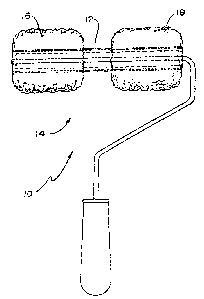Une partie des informations de ce site Web a été fournie par des sources externes. Le gouvernement du Canada n'assume aucune responsabilité concernant la précision, l'actualité ou la fiabilité des informations fournies par les sources externes. Les utilisateurs qui désirent employer cette information devraient consulter directement la source des informations. Le contenu fourni par les sources externes n'est pas assujetti aux exigences sur les langues officielles, la protection des renseignements personnels et l'accessibilité.
L'apparition de différences dans le texte et l'image des Revendications et de l'Abrégé dépend du moment auquel le document est publié. Les textes des Revendications et de l'Abrégé sont affichés :
| (12) Demande de brevet: | (11) CA 2338109 |
|---|---|
| (54) Titre français: | ROULEAU A PEINTURE A SURFACE DOUBLE PERMETTANT DE CREER DES MOTIFS ALEATOIRES ET METHODE DE PRODUCTION D'UN FAUX FINI |
| (54) Titre anglais: | DUAL-SURFACE RANDOM GENERATING PAINT ROLLER AND METHOD OF PRODUCING A FAUX FINISH |
| Statut: | Réputée abandonnée et au-delà du délai pour le rétablissement - en attente de la réponse à l’avis de communication rejetée |
| (51) Classification internationale des brevets (CIB): |
|
|---|---|
| (72) Inventeurs : |
|
| (73) Titulaires : |
|
| (71) Demandeurs : |
|
| (74) Agent: | |
| (74) Co-agent: | |
| (45) Délivré: | |
| (22) Date de dépôt: | 2001-02-26 |
| (41) Mise à la disponibilité du public: | 2001-08-24 |
| Licence disponible: | S.O. |
| Cédé au domaine public: | S.O. |
| (25) Langue des documents déposés: | Anglais |
| Traité de coopération en matière de brevets (PCT): | Non |
|---|
| (30) Données de priorité de la demande: | ||||||
|---|---|---|---|---|---|---|
|
A faux finishing device including a paint roller having
a core defined along a central axis. The core has an
aperture therethrough that is aligned along the central
axis. The device also has one or more roller bodies
attached to the exterior surface of the core. Each body has
an exterior surface that allows the device to create a
random pattern when the body is coated with paint and placed
in contact with a surface to be painted.
Note : Les revendications sont présentées dans la langue officielle dans laquelle elles ont été soumises.
Note : Les descriptions sont présentées dans la langue officielle dans laquelle elles ont été soumises.

2024-08-01 : Dans le cadre de la transition vers les Brevets de nouvelle génération (BNG), la base de données sur les brevets canadiens (BDBC) contient désormais un Historique d'événement plus détaillé, qui reproduit le Journal des événements de notre nouvelle solution interne.
Veuillez noter que les événements débutant par « Inactive : » se réfèrent à des événements qui ne sont plus utilisés dans notre nouvelle solution interne.
Pour une meilleure compréhension de l'état de la demande ou brevet qui figure sur cette page, la rubrique Mise en garde , et les descriptions de Brevet , Historique d'événement , Taxes périodiques et Historique des paiements devraient être consultées.
| Description | Date |
|---|---|
| Demande non rétablie avant l'échéance | 2006-02-27 |
| Le délai pour l'annulation est expiré | 2006-02-27 |
| Réputée abandonnée - omission de répondre à un avis sur les taxes pour le maintien en état | 2005-02-28 |
| Lettre envoyée | 2002-02-15 |
| Inactive : Transfert individuel | 2002-01-11 |
| Demande publiée (accessible au public) | 2001-08-24 |
| Inactive : Page couverture publiée | 2001-08-23 |
| Modification reçue - modification volontaire | 2001-04-23 |
| Inactive : CIB attribuée | 2001-04-20 |
| Inactive : CIB en 1re position | 2001-04-20 |
| Inactive : Lettre de courtoisie - Preuve | 2001-04-03 |
| Demande reçue - nationale ordinaire | 2001-03-27 |
| Exigences de dépôt - jugé conforme | 2001-03-27 |
| Inactive : Certificat de dépôt - Sans RE (Anglais) | 2001-03-27 |
| Date d'abandonnement | Raison | Date de rétablissement |
|---|---|---|
| 2005-02-28 |
Le dernier paiement a été reçu le 2004-02-24
Avis : Si le paiement en totalité n'a pas été reçu au plus tard à la date indiquée, une taxe supplémentaire peut être imposée, soit une des taxes suivantes :
Veuillez vous référer à la page web des taxes sur les brevets de l'OPIC pour voir tous les montants actuels des taxes.
| Type de taxes | Anniversaire | Échéance | Date payée |
|---|---|---|---|
| Taxe pour le dépôt - petite | 2001-02-26 | ||
| Enregistrement d'un document | 2001-02-26 | ||
| TM (demande, 2e anniv.) - petite | 02 | 2003-02-26 | 2003-02-24 |
| TM (demande, 3e anniv.) - petite | 03 | 2004-02-26 | 2004-02-24 |
Les titulaires actuels et antérieures au dossier sont affichés en ordre alphabétique.
| Titulaires actuels au dossier |
|---|
| THE WOOLIE, INC. |
| Titulaires antérieures au dossier |
|---|
| DAVID M. TOLCHINER |